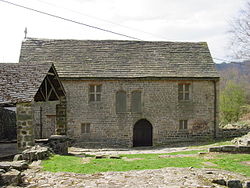Padley Chapel
| Padley Chapel | |
|
Derbyshire | |
|---|---|
 The chapel and remains of Padley Hall | |
| Location | |
| Grid reference: | SK24687896 |
| Location: | 53°18’25"N, 1°37’52"W |
| Village: | Upper Padley |
| History | |
| Built 14th / 15th centuries | |
| Information | |
Padley Chapel is a mediæval chapel, once that of the manor house, in Upper Padley, near Grindleford in Derbyshire, on the site of the former Padley Hall (or Padley Manor). The chapel is a Grade I listed building.[1]
Padley Hall
Padley Hall was a large double courtyard house. It was owned in the Elizabethan Age by a recusant family, the Fitzherbert Family. Here, in 1588, the Earl of Shrewsbury raided the house seeking to arrest John FitzHerbert and discovered two Romanist priests, Nicholas Garlick and Robert Ludlum: two weeks later the priests were drawn, hanged and quartered at St Mary's Bridge in Derby for treason. They became known to Roman Catholics as the 'Padley Martyrs'.[1]
The house today is mostly in ruins, and is a Scheduled Monument.[2]
Chapel
Part of Padley Hall—probably originally the central gatehouse range—survives, and in 1933 was converted to a Roman Catholic chapel in honour of the martyrs.[3]
The chapel close to the railway line, a short distance west of Grindleford railway station. A pilgrimage takes place every year in July.
| ("Wikimedia Commons" has material about Padley Chapel) |
References
- ↑ 1.0 1.1 National Heritage List 1335033: Padley Chapel (Grade I listing)
- ↑ National Heritage List 1017587: Padley Hall: a mediæval great house (Scheduled ancient monument entry)
- ↑ Redfern, Roger (2006). Portrait of the Hope Valley: A Personal View in Pictures (2nd ed.). The Cottage Press. p. 11.
